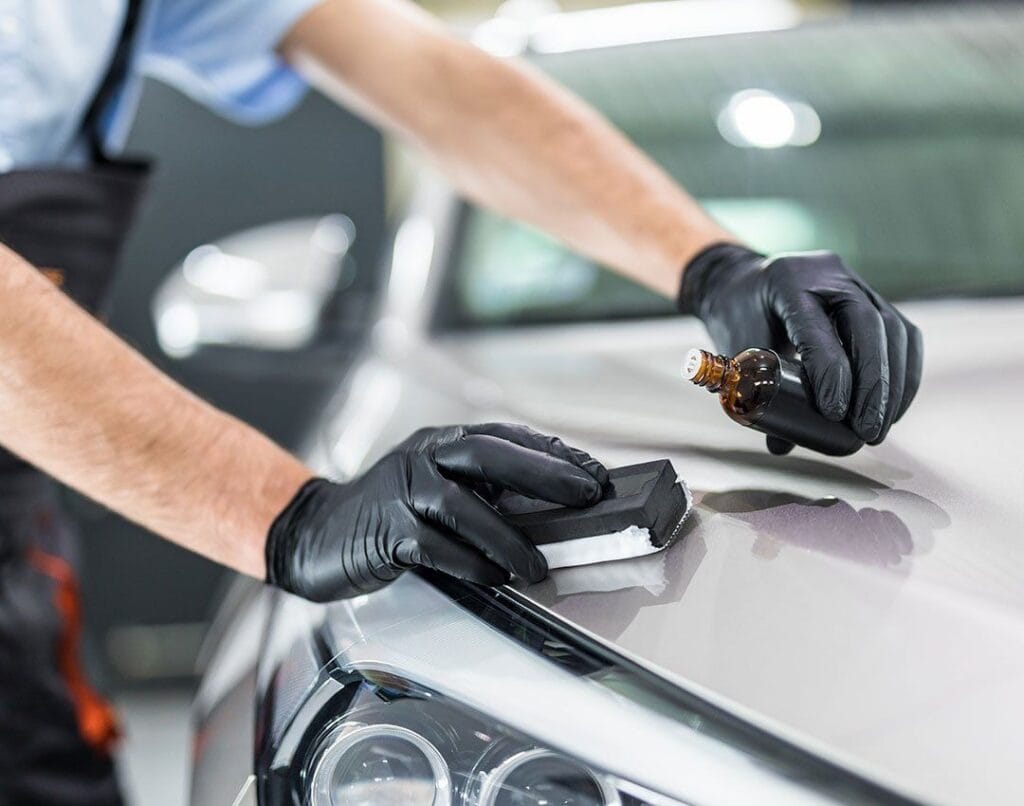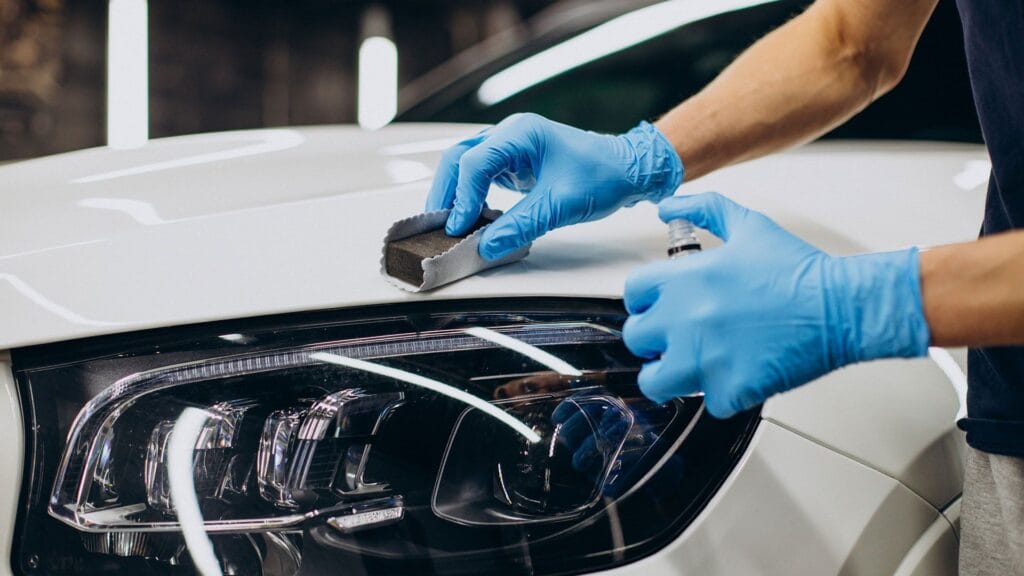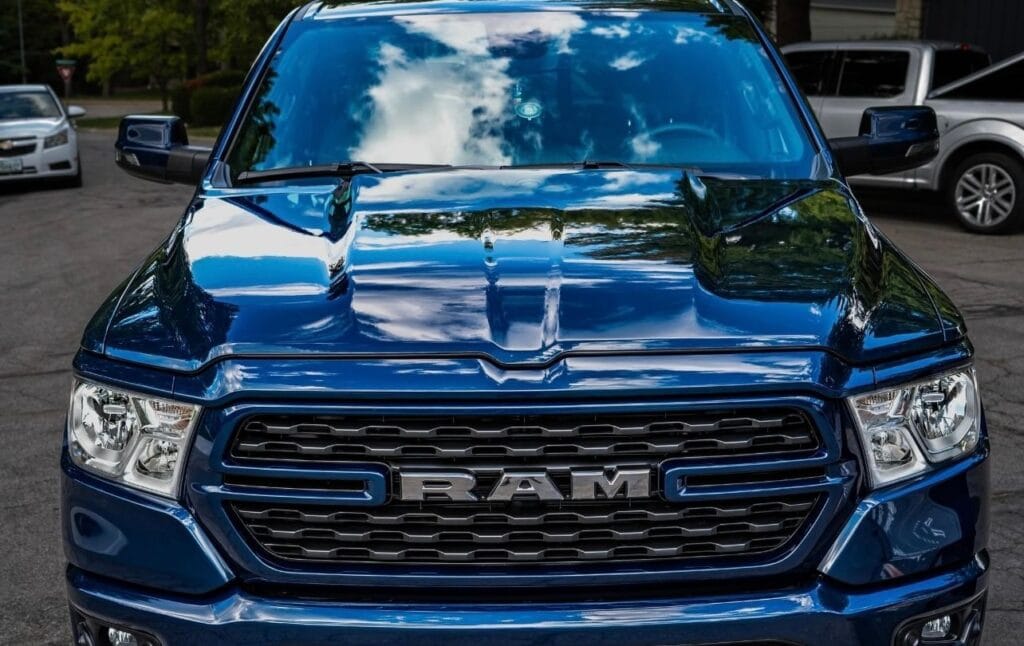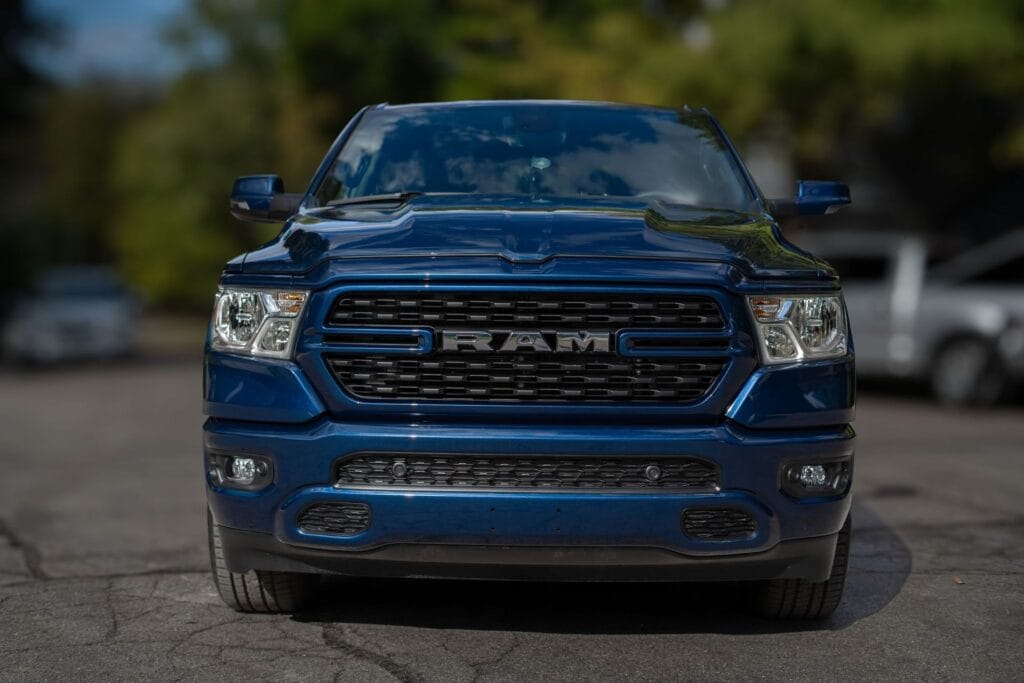Ceramic coatings, made from nano-sized materials like silicon dioxide, show their strength by casting off water. These miniature particles create a surface that doesn’t play well with water, causing it to round up into tiny beads and roll away rather than spread out. This unfriendly behavior towards water is its biggest asset, especially for cars where rainy dirt becomes a rinse-off task instead of a scrub-off chore. Imagine that for your car every time it rains.
Ceramic coatings do not let water stick to them because the nanoparticles repel water, so they have a high contact angle with water droplets. This causes water to bead up and roll off the surface, carrying dirt and grime with it, thereby keeping the coated surface clean and protected.
Ceramic Coatings: Water Repellency Properties
When you think of something ‘hydrophobic’, you might imagine a superhero who repels water like some kind of mystical force field. Well, ceramic coatings are kind of like that for your car. They’re like an invisible shield for your vehicle, helping to keep it looking clean and shiny even when exposed to the elements with their superior water-repellent properties. Water repellency means that water doesn’t stick or get absorbed. Instead, it forms little beads and rolls off. This is due to the nanoscopic structures present in these coatings, which alter the surface tension of water, making it less likely to spread out and create water spots. This means that when rain falls on your car or a puddle splashes up from the road, the water isn’t going to sit there and slowly evaporate, leaving behind ugly marks and stains. Instead, it builds up into beads and then, when you drive off, they roll right off the surface, taking dirt and grime with them.
Benefits of Water Repellency
The benefits aren’t just aesthetic either; keeping your car’s exterior clean is more than just vanity. Reduced water spots mean less need for washing and less time spent rubbing those stubborn spots. Additionally, the rolling droplets’ ability to whisk away dirt and grime reduces the possibility of debris scratching the paintwork. It’s also smarter to embrace this self-cleaning feature because ceramic coatings are super durable—they can last for months or even years with proper care and maintenance; thanks to their water-repellent properties, they maintain their protective function for longer periods. Think of it as giving your car a suit of armor against water damage!
By forming a hydrophobic barrier at the nanoscale level, ceramic coatings work wonders in preventing water spots, maintaining cleanliness, and reducing the need for frequent washes—all while providing long-lasting protection for your vehicle’s exterior.


The Science Behind Hydrophobic Coatings
Ever noticed how raindrops bead up and roll off a freshly coated car? That’s hydrophobicity in action! The term “hydrophobic” literally means “afraid of water,” and ceramic coatings with this quality actively repel water. Understanding the science behind this can help us see why hydrophobic coatings are so effective and how they’re able to keep surfaces dry and clean. The secret lies in the nanoparticles, particularly silicon dioxide (SiO2), used in hydrophobic coatings. When applied to a surface, these nanoparticles create a microscopic landscape with tiny peaks and valleys. This irregular surface creates a physical barrier that repels water, causing it to form droplets rather than spreading out.
This phenomenon is based on intermolecular forces—a fancy way of saying the attraction and repulsion between molecules. Water molecules like to stick together, thanks to their polarity, but they don’t like sticking to other surfaces if they can help it. When a surface is coated with hydrophobic material, the geometric structure of the coating minimizes the contact area between water and the surface. This effectively reduces the attractive forces between them, causing water to bead up and easily roll off. Think of it like a bumpy road for water droplets; instead of spreading out and soaking into the pavement, they stay on top and easily roll away. This is why, when you spill water on a hydrophobically coated surface, it forms droplets that you can simply wipe away with ease.
Levels of Hydrophobicity in Ceramic Coatings
When evaluating the hydrophobic properties of ceramic coatings, considering the contact angle between water and the coated surface is crucial. This contact angle measures how much the water droplet beads up on the surface, indicating the coating’s effectiveness in repelling water. A higher contact angle signifies greater hydrophobicity. A ceramic coating with a contact angle exceeding 100 degrees results in excellent water beading. This means that water forms compact droplets on the surface, effortlessly rolling off and taking contaminants with it rather than spreading out and sticking to the coating.
Ceramic coatings with superior hydrophobicity offer remarkable benefits, such as increased durability and prolonged protection for painted surfaces. Water beading not only enhances the aesthetic appeal by maintaining a clean, glossy appearance, but it also facilitates easier cleaning as dirt and contaminants are less likely to adhere to the surface. This prolonged cleanliness ensures that your vehicle or other coated surfaces look pristine for an extended period of time. The reduced adhesion of contaminant particles also means that the coating is better equipped to resist environmental factors, such as UV rays, road salt, and chemical stains.
For instance, imagine heavy rain or snow falling on your vehicle treated with a highly hydrophobic ceramic coating. Instead of creating a messy sheet of water or pooling in place, the water would instantly bead up and roll off the surface, along with any dust or grime picked up along the way. This not only saves you time by minimizing regular cleaning efforts but also preserves the structural integrity of the coated surface. It’s important to note that while a high contact angle suggests superior hydrophobicity, achieving and maintaining such performance requires proper application and periodic maintenance to ensure longevity and effectiveness.
Benefits of Water-Repellent Ceramic Coatings
Water-repellent ceramic coatings offer a range of advantages that make them a popular choice for protecting various surfaces. Let’s take a closer look at some of these benefits and understand why they are highly sought after in the world of surface protection.
- Surface Protection: One of the significant benefits of water repellent ceramic coatings is their ability to provide robust protection against water-induced damage. Whether it’s preventing stains or corrosion on vehicles, these coatings act as a shield, safeguarding surfaces from the detrimental effects of water exposure. By creating a hydrophobic barrier, ceramic coatings repel water and prevent it from seeping into and damaging the underlying material. This proactive defense helps maintain the integrity and longevity of surfaces, prolonging their lifespan and reducing the need for frequent repairs or maintenance.
- Enhanced Aesthetics: In addition to their protective qualities, water repellent ceramic coatings also play a key role in enhancing the aesthetics of treated surfaces. By promoting water beading, these coatings contribute to maintaining the shine and luster of surfaces, ensuring they retain a glossy and well-maintained appearance. When water droplets bead up and roll off the surface instead of spreading out and leaving marks, it not only keeps surfaces looking pristine but also reduces the need for frequent cleaning and maintenance.
- Longevity: Moreover, the hydrophobic properties of water repellent ceramic coatings significantly contribute to their durability and longevity. These coatings are designed to withstand harsh environmental conditions, including exposure to UV rays, extreme temperatures, and chemical contaminants. By repelling water and resisting moisture-related deterioration, ceramic coatings can maintain their effectiveness over an extended period, providing long-term protection for treated surfaces. This extended resilience makes them a cost-effective investment for preserving the condition of surfaces and minimizing the need for frequent recoating or replacement.
From safeguarding surfaces against water-induced damages to preserving their aesthetic appeal and ensuring long-lasting protection, it’s clear that water repellent ceramic coatings offer a comprehensive suite of benefits that cater to diverse surface maintenance needs.


Impact of Ceramic Coatings on Dirt and Oil Resistance
Ceramic coatings actively repel dirt, oil, and grime from sticking to the surface they protect. This feature is invaluable for vehicles, especially when encountering muddy, rainy, or messy road conditions. Without a protective coating, a vehicle’s surface can quickly become dirty and challenging to clean. But with a quality ceramic coating, the hydrophobic nature of the coating prevents contaminants from adhering to the surface. It’s like having a protective shield around your car or motorcycle. When mud splashes onto a coated surface, it effortlessly slides off, thanks to the water-repelling properties.
A fully coated vehicle offers more than just maintaining its appearance; it means that you have a better chance of removing contaminants without leaving traces behind. In addition to repelling water, ceramic coatings also exhibit remarkable resistance to oils. This is particularly useful in scenarios where accidental spills or leakages might occur. For example, if you happen to spill engine oil during maintenance on your vehicle, the slick ceramic coating will ensure that cleaning up is easier than ever. The same principle applies to other types of oil found on roads, such as motor oil or other greasy substances. With a ceramic coating in place, these substances will struggle to bond with the surface, making it much simpler to keep your vehicle clean during regular maintenance.
It’s not just about ease of cleaning; it’s about protection and longevity. The very nature of ceramic coatings lends itself to both aesthetics and function. In essence, ceramic coatings act as shields against dirt and oil, actively reducing the effort needed to maintain cleanliness. This is a significant advantage for anyone who values keeping their vehicles looking pristine while also minimizing the time and effort required for upkeep.
Adhesion Process of Ceramic Coating on Surfaces
When it comes to ceramic coatings, one of the crucial aspects is how well they adhere to the surface they’re applied to. This process is essential for establishing a durable and long-lasting bond. This process begins with thorough surface preparation. Just as you wouldn’t apply wallpaper over peeling paint or dirty walls, ceramic coatings need a clean canvas to achieve their optimal adhesion. Any dirt, grease, or other contaminants left on the surface can compromise the bonding process and reduce the effectiveness of the coating.
Importance of Surface Preparation
Proper surface preparation involves several essential steps, including cleaning and decontamination. Before a ceramic coating application, the surface must be cleaned to remove dust, dirt, and other impurities that could interfere with adhesion. Another crucial step is decontamination. This step involves removing any residual oils, waxes, or previously applied substances that could create a barrier between the coating and the surface. This thorough preparation creates the ideal conditions for the ceramic coating to form a strong and lasting bond. Once the surface is meticulously prepared, the application of the ceramic coating initiates a chemical bonding process with the surface.
The Chemical Bonding Process
When the liquid ceramic coating is applied, it seeps slightly into the clear coat surface, forming a densely interwoven network of nanoparticles. This network provides the foundation for subsequent chemical reactions that occur as part of the curing process. Heat or UV light triggers additional chemical reactions within this nanoparticle network, further enhancing its bonding with the substrate. The end result is an ultrathin and durable layer that becomes part of the surface itself through covalent bonds. This molecular integration ensures that the ceramic coating doesn’t just sit on top of the substrate but becomes an integral part of it.
Think of it like adding a protective shield to your phone screen using an adhesive protector. The protector chemically bonds with the glass surface, creating a seamless and durable layer that enhances resilience while maintaining clarity—a similar principle operates at a molecular level in ceramic coatings. With this chemical bonding in place, the ceramic coating not only provides water repellency and protective properties but also contributes to preserving substrates over time. Understanding this intricate adhesion process gives us insight into how ceramic coatings create robust protective layers on surfaces while enhancing their longevity and performance.
Unbeatable Ceramic Coating Services in Overland Park, KS
Experience unrivaled excellence in automotive care with Ricks Reflections Mobile Detailing, your go-to destination for unbeatable ceramic coating services in Overland Park, KS. Our dedicated team of professionals is committed to providing meticulous attention to detail and top-quality products, ensuring that your vehicle receives the ultimate protection and shine it deserves. Drive with confidence, knowing that your car is shielded from the elements while maintaining its pristine appearance. Trust Ricks Reflections Mobile Detailing to exceed your expectations—schedule your ceramic coating appointment today and experience the difference for yourself! Call us at (913) 777-9545 to get started!
